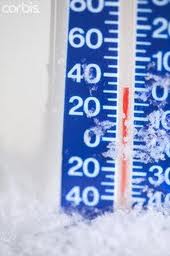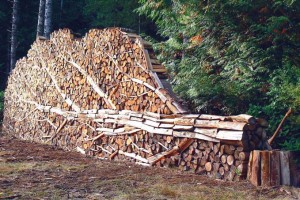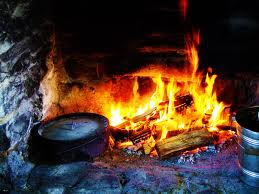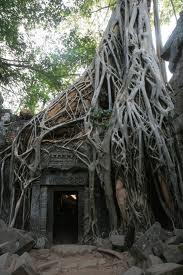An arctic express of frigid air recently sped down and across the United States. Here in Florida it snowed for the second time in 33 years, delivering a week record-setting temperatures below freezing.
 For many plants 32º F or 0º C is falling off a cliff, and Ma nature doesn’t care who she shoves off, invasive weeds or pampered ornamentals. I’m afraid my mango tree will never recover. The carombola (star fruit) might. I’m about 50 miles north of its most northern commercial range but in a protected spot, and it’s about 10 years old so we will see. The avocado is well-established so it should make it.
For many plants 32º F or 0º C is falling off a cliff, and Ma nature doesn’t care who she shoves off, invasive weeds or pampered ornamentals. I’m afraid my mango tree will never recover. The carombola (star fruit) might. I’m about 50 miles north of its most northern commercial range but in a protected spot, and it’s about 10 years old so we will see. The avocado is well-established so it should make it.
Despite complaints, there are some advantages to cold weather. My olives should fruit this year, getting the necessary chill hours. And a lot of invasives that have had over three decades to proliferate, such as Brazilian Pepper, will be frozen down for another generation. There is a park in Cocoa, Florida, that is so overrun with Brazilian Pepper that I could find only 13 edible species in an area that should support easily six dozen or more.
 During the cold snap frugal Green Deane burned wood in his fireplace to keep warm. Cutting down a tree to stay warm is certainly a green debate. This wood, however, was scrap wood headed for a land fill. And it was free, not a small consideration. It came from a company that imports slabs of granite from Brazil and India. That granite comes packed in shipping crates and inside the crates the slabs are kept from shifting by wood. A lot of wood. For years the company had literally boxcar size piles of scrap wood they could not give away, basically because they are also full of nails and bolts. My fireplace, however, does not care. I consider the hot iron just more radiant heat.
During the cold snap frugal Green Deane burned wood in his fireplace to keep warm. Cutting down a tree to stay warm is certainly a green debate. This wood, however, was scrap wood headed for a land fill. And it was free, not a small consideration. It came from a company that imports slabs of granite from Brazil and India. That granite comes packed in shipping crates and inside the crates the slabs are kept from shifting by wood. A lot of wood. For years the company had literally boxcar size piles of scrap wood they could not give away, basically because they are also full of nails and bolts. My fireplace, however, does not care. I consider the hot iron just more radiant heat.
So, burning scrap wood is keeping wood from a landfill — green — but it’s putting smoke and particulate matter into the air — not green. Then again, forest fires put smoke and particulate matter into the air. And of course the all-time champs of that are volcanos. Mother Nature isn’t too “green” herself.
 On the other hand I did not pay the power company extra to keep me warm, so they used a little less fuel. Green. And with my cast iron pan collection I cooked with the fire, also using less electricity, more green. As for edibles weeds, they did suffer. The frosts seems to be more damaging than the freezes. But those will fertilize the next generation. Which brings us to exactly what is being “green?”
On the other hand I did not pay the power company extra to keep me warm, so they used a little less fuel. Green. And with my cast iron pan collection I cooked with the fire, also using less electricity, more green. As for edibles weeds, they did suffer. The frosts seems to be more damaging than the freezes. But those will fertilize the next generation. Which brings us to exactly what is being “green?”
 Are beavers green? They cut down healthy trees, using only the branches. They block the natural flow of a stream by building dams, not only altering the environment upstream but downstream when the dam eventually breaks. Beavers have no concern for the fish up or downstream, the erosion their dams cause, or what all that rotting wood does. Beavers it would seem are not green.
Are beavers green? They cut down healthy trees, using only the branches. They block the natural flow of a stream by building dams, not only altering the environment upstream but downstream when the dam eventually breaks. Beavers have no concern for the fish up or downstream, the erosion their dams cause, or what all that rotting wood does. Beavers it would seem are not green.
 of the strangler fig? It takes over trees and kills them. Not exactly friendly or green. For that matter, what of the parasitic wasp. It lays its eggs in other bugs and its offsprings live off the host, killing it. And we call that wasp “beneficial” because we don’t like the bug it infests. For that matter is cancer green? After all it kills people and people are harming the environment so maybe in the long run cancer is more green than the beaver. “Green” just might be a matter of degree and definition, and those may come and go like the tide. Green seems to be whatever one wants it to be.
of the strangler fig? It takes over trees and kills them. Not exactly friendly or green. For that matter, what of the parasitic wasp. It lays its eggs in other bugs and its offsprings live off the host, killing it. And we call that wasp “beneficial” because we don’t like the bug it infests. For that matter is cancer green? After all it kills people and people are harming the environment so maybe in the long run cancer is more green than the beaver. “Green” just might be a matter of degree and definition, and those may come and go like the tide. Green seems to be whatever one wants it to be.
My measuring tool of green is gastronomic. If I can eat an edible weed because the ground and water are wholesome, then we are doing something right. If it is not edible because the ground or water is not wholesome, we are doing something wrong. And that is one reason why I teach foraging. It makes pollution personal. And if that helps make a person “green” what ever that is, then all the better.

